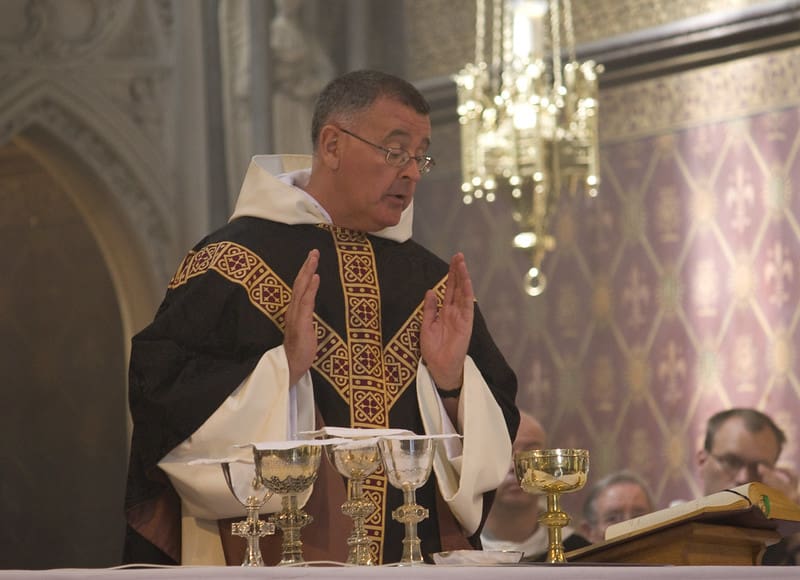In the previous post, the Liturgical Traditions series examined the postures and gestures which are common to the celebration of all the Eucharistic Prayers authorized in the Missal of Paul VI. In this post, the series continues with the gestures specific to the first Eucharistic Prayer, called the Roman Canon, since this particular Eucharistic Prayer is considerably different in structure from the other Eucharistic Prayers. (For those not intimately familiar with the texts and rubrics of the Eucharistic Prayers, they are available here.)
In the case of Eucharistic Prayer I, the sign of the cross over the gifts is made at the beginning of the prayer, whereas in the other Eucharistic Prayers it comes later, after the epiclesis, or “calling down” of the Holy Spirit. The celebrant joins both hands momentarily prior to making the sign of the cross. He lowers his left hand flat on the altar outside the corporal, while making the sign of the cross with his right. The right hand is held perpendicular to the altar, fingers joined, hand extended straight. The sign of the cross is made from the upper edge of the corporal to the host and then from the left edge of the corporal to the right edge (See André Mutel and Peter Freeman, Cérémonial de la Sainte Messe, Éditions Artège, 2012, 133). The entire sign of the cross is made in the same plane, without lowering the hand or the fingers. After making the sign of the cross, the celebrant joins both hands before extending them to continue with the prayer.
The celebrant bows his head at the names of Jesus, Mary, and of the saint commemorated that day. Where the celebrant exercises the option to conclude portions of the prayer with “Through Christ our Lord. Amen,” he joins his hands together at each occasion before continuing (See A. Mutel and P. Freeman, Cérémonial, 135). These conclusions indicate that the Roman Canon was composed over time of independent segments, each of which ended with “Through Christ our Lord. Amen.” Since the entire Eucharistic Prayer is a priestly prayer, the celebrant himself says both the conclusion, “Through Christ our Lord,” and its response, “Amen.” Even if he does not exercise this option throughout the prayer, he always joins his hands at the conclusion of the section which begins, “Therefore Lord we pray,” since he will then open his joined hands over the gifts at the beginning of the next section, the epiclesis, with the words, “Be pleased, O Lord, we pray.”
Following the consecration, at the section which begins, “In humble prayer, we ask you,” the celebrant bows with hands joined. Historically, the tips of the index and third fingers were placed on the top of the altar and the tips of the other fingers were touching the edge of the altar. At the conclusion of the section, the celebrant stands erect and signs himself with his right hand, opened flat with fingers joined, his left hand resting on his chest. The celebrant will take care that his right hand extends no lower that the position of his left hand on his chest. Having made the sign of the cross, he joins both hands momentarily before proceeding with, “Remember also Lord, your servants N. and N.”
When commemorating both the living (“Remember Lord your servants”) and the dead (“Remember also, Lord, your servants N. and N.”), the celebrant has traditionally drawn his joined hands toward his face for the time spent in silent prayer before proceeding with hands extended in the usual orans position.
At the words, “To us, also your servants,” the celebrant strikes his breast with the right hand held open with the fingers joined. The right hand is not held clenched in a fist. The gesture is made with the elbow close to the body and the entire forearm rotating smoothly toward the breast without any exertion. During this time, the left hand is placed flat on the altar inside the corporal. The celebrant then continues with hands in the orans position until the end of this section, when, as always, he joins both hands at “Through Christ our Lord.”
While saying, “Through whom you continue,” the celebrant (or the deacon) may uncover the chalice in the usual manner. The celebrant may hand the chalice to the deacon with his right hand and take the paten in both hands, ready to elevate the paten at the final words, “Through him, and with him, and in him.”
In the next post, this series will examine more closely the postures and gestures of the deacon during the Eucharistic prayer as well as those of concelebrants. These differ in various ways from the postures and gestures of the principal celebrant himself. However, once again, the traditional practice of the Roman rite can be helpful in rendering the participation of the deacon and concelebrants more orderly and graceful at every celebration of Mass.



